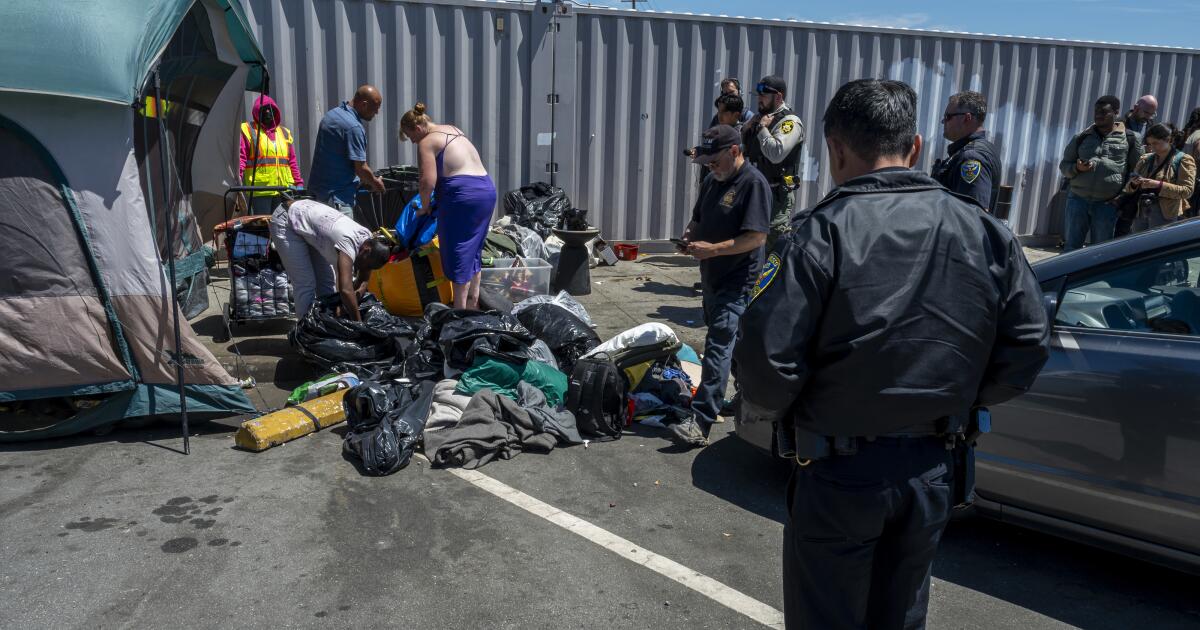A week into what Mayor London Breed has called a “very aggressive” effort to clear homeless encampments across San Francisco, a key question looms: Where will the people living in those tents go?
Outreach workers, backed by law enforcement officers, have fanned out in recent days in targeted efforts to clear some of San Francisco’s most visible encampments, confiscating personal belongings and telling the owners it’s time to pack up and go.
They’ve cleared unsanctioned tent cities under freeways and a stretch of sidewalk in the drug-plagued Tenderloin with the aim of forcing people off the streets. On Monday, city workers visited a longtime encampment lining the sidewalks outside San Francisco’s only DMV office that had been cleared more than a dozen times this year only to resurrect days later.
By Monday night, the sidewalks were clean.
Breed’s efforts are buoyed by a pivotal June 28 U.S. Supreme Court ruling that authorized local communities to more forcefully restrict homeless encampments on sidewalks and other public property.
In response, Breed said that San Francisco, a city that’s become a favorite right-wing punching bag for its sprawling homelessness crisis, would launch a more determined initiative to clear encampments. The time had come, she said, to address “this issue differently than we have before.”
Despite a years-long effort to move people into shelter or housing, street encampments remain a visible problem in San Francisco.
(Tayfun Coskun / Getty Images)
An estimated 8,300 people are living homeless in San Francisco, about half of them sleeping in parks and on sidewalks in makeshift shelters. Despite a years-long effort to move people into temporary shelter or permanent housing, tent encampments remain a glaring problem, often accompanied by trash, theft and open drug use.
For years, Breed and other city officials said their hands were tied by decisions issued by the U.S. Court of Appeals for the 9th Circuit that deemed it cruel and unusual punishment to penalize someone for sleeping on the streets if no legal shelter was available. Now, bolstered by the Supreme Court ruling, city personnel can take a tougher stance if people refuse help.
But San Francisco, along with many other West Coast cities looking to crack down on encampments, still hasn’t figured out where people are supposed to go once their tents are dismantled: The city’s shelters — with roughly 3,600 beds — are at 94% of capacity, according to the San Francisco Department of Homelessness and Supportive Housing.
“Unfortunately, San Francisco does not have enough shelter or housing for every person experiencing homelessness, but we do have some beds available each day to support the work of the outreach teams, and we continue to grow our system,” Emily Cohen, the department’s spokesperson, wrote in an email.
Jeff Cretan, the mayor’s spokesperson, said the city doesn’t necessarily expect a huge influx of new people in shelters. After years of attempts to move people inside, those still living on the streets tend to be the most resistant to accepting offers of shelter, often because they’re struggling with mental illness and substance-use disorders.
In the first three days of this week’s encampment sweeps, only about 10% of the people offered shelter have accepted it, Cretan said.
Instead, Breed — in the thick of a difficult reelection bid — is turning to strategies other than more shelter beds. She said the city may issue criminal penalties for people who repeatedly refuse shelter. But the prospect of local jails processing hundreds more homeless people also raises capacity issues.
On Thursday, Breed put weight behind another approach. She issued an executive directive requiring outreach workers to offer homeless people who aren’t from San Francisco free transportation out of town — to cities where they have family, friends or other connections. Cretan said the city would cover the cost of bus, plane or train fares.
The city has had a similar program in effect for years, but it lost traction during the pandemic. Under the new directive, workers are to press the relocation option before offering any other city services, including housing and shelter.
According to the city’s 2024 annual point-in-time homeless survey, about 40% of people living on the streets said they were not from San Francisco.
“This directive will ensure that relocation services will be the first response to our homelessness and substance-use crises, allowing individuals the choice to reunite with support networks before accessing other city services or facing the consequences of refusing care,” Breed wrote in the directive.

San Francisco Mayor London Breed faces a difficult reelection bid, with homeless numbers a burning issue. Board of Supervisors President Aaron Peskin, right, is among her challengers.
(Eric Risberg / Associated Press)
Breed’s hard-line approach has drawn sharp criticism from homeless advocates, who argue that clearing tents does not address the poverty and addiction that cause homelessness — and who say her efforts are politically motivated.
“Policies to address homelessness must be humane, lawful and effective — not implemented just because someone’s job is on the line,” said Aaron Peskin, president of the San Francisco Board of Supervisors and one of Breed’s mayoral challengers.
Peskin instead called for bolstering rent control and protections against eviction, and for the city to expand shelter and affordable housing options.
Since Breed took office, the city has increased shelter capacity from about 2,500 beds to nearly 4,000, the mayor’s office said, and permanent supportive housing slots to about 14,000. Cohen, with the Department of Homelessness and Supportive Housing, cited those efforts as the reason the number of people living on city streets is at “the lowest level in at least 10 years.”
Cretan said the relocation offers and threat of criminal penalties are just a starting point as the city figures out what strategies will work.
“The mayor really wants to make clear [that] you have to accept shelter. But, clearly, it’s not going to be everyone says yes,” Cretan said. “It’s not like you snap your fingers and everything changes overnight.”
